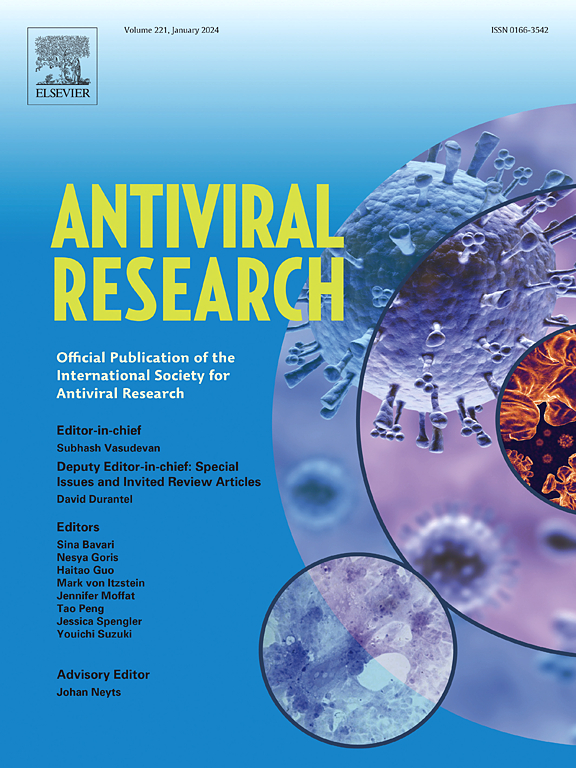二氢乙酸脱氢酶抑制剂与4′-氟吡啶的广泛抗病毒活性协同作用。
IF 4.5
2区 医学
Q1 PHARMACOLOGY & PHARMACY
引用次数: 0
摘要
RNA病毒对人类健康构成持续威胁,通常只有有限的疫苗接种或治疗选择。值得注意的例子包括具有大流行潜力的流感病毒和冠状病毒。丝状病毒和亨尼帕病毒引起的暴发更有限,但致死率很高。所有RNA病毒都依赖于病毒编码的RNA依赖性RNA聚合酶(RdRp)的活性。一种抗病毒核苷类似物4′-氟吡啶(4′-FlU)靶向RdRp,并通过与新生病毒RNA结合和延迟链终止来减少几种RNA病毒的复制,包括甲型流感病毒和SARS-CoV-2。然而,4'-FlU的有效浓度在不同的病毒中有所不同,因此需要加强其功效。本研究表明,二氢乙酸脱氢酶(DHODH)是嘧啶生物合成所必需的酶,其抑制剂可以协同增强4'-FlU对甲型流感病毒、SARS-CoV-2、亨尼帕病毒和埃博拉病毒的抗病毒作用。即使是抗4'-FlU突变型甲型流感病毒也能通过DHODH抑制对4'-FlU重新致敏。尿嘧啶的加入挽救了甲型流感病毒的复制,这强烈表明尿嘧啶耗竭是这种协同作用的一种机制。在新冠病毒仓鼠模型中,4′-FlU对SARS-CoV-2也非常有效。我们认为,抑制DHODH对内源性尿苷合成的损害促进了4'-FlU与病毒rna的结合。该策略可广泛应用于提高嘧啶核苷类似物抗病毒治疗的疗效。本文章由计算机程序翻译,如有差异,请以英文原文为准。

Inhibitors of dihydroorotate dehydrogenase synergize with the broad antiviral activity of 4′-fluorouridine
RNA viruses present a constant threat to human health, often with limited options for vaccination or therapy. Notable examples include influenza viruses and coronaviruses, which have pandemic potential. Filo- and henipaviruses cause more limited outbreaks, but with high case fatality rates. All RNA viruses rely on the activity of a virus-encoded RNA-dependent RNA polymerase (RdRp). An antiviral nucleoside analogue, 4′-Fluorouridine (4′-FlU), targets RdRp and diminishes the replication of several RNA viruses, including influenza A virus and SARS-CoV-2, through incorporation into nascent viral RNA and delayed chain termination. However, the effective concentration of 4′-FlU varied among different viruses, raising the need to fortify its efficacy. Here we show that inhibitors of dihydroorotate dehydrogenase (DHODH), an enzyme essential for pyrimidine biosynthesis, can synergistically enhance the antiviral effect of 4′-FlU against influenza A viruses, SARS-CoV-2, henipaviruses, and Ebola virus. Even 4′-FlU-resistant mutant influenza A virus was re-sensitized towards 4′-FlU by DHODH inhibition. The addition of uridine rescued influenza A virus replication, strongly suggesting uridine depletion as a mechanism of this synergy. 4′-FlU was also highly effective against SARS-CoV-2 in a hamster model of COVID. We propose that the impairment of endogenous uridine synthesis by DHODH inhibition enhances the incorporation of 4′-FlU into viral RNAs. This strategy may be broadly applicable to enhance the efficacy of pyrimidine nucleoside analogues for antiviral therapy.
求助全文
通过发布文献求助,成功后即可免费获取论文全文。
去求助
来源期刊

Antiviral research
医学-病毒学
CiteScore
17.10
自引率
3.90%
发文量
157
审稿时长
34 days
期刊介绍:
Antiviral Research is a journal that focuses on various aspects of controlling viral infections in both humans and animals. It is a platform for publishing research reports, short communications, review articles, and commentaries. The journal covers a wide range of topics including antiviral drugs, antibodies, and host-response modifiers. These topics encompass their synthesis, in vitro and in vivo testing, as well as mechanisms of action. Additionally, the journal also publishes studies on the development of new or improved vaccines against viral infections in humans. It delves into assessing the safety of drugs and vaccines, tracking the evolution of drug or vaccine-resistant viruses, and developing effective countermeasures. Another area of interest includes the identification and validation of new drug targets. The journal further explores laboratory animal models of viral diseases, investigates the pathogenesis of viral diseases, and examines the mechanisms by which viruses avoid host immune responses.
 求助内容:
求助内容: 应助结果提醒方式:
应助结果提醒方式:


